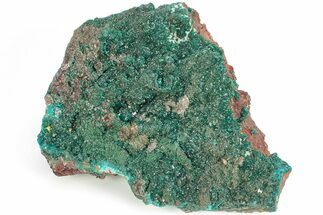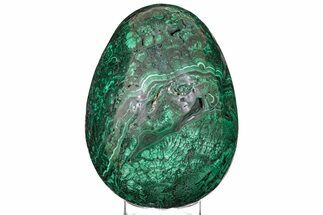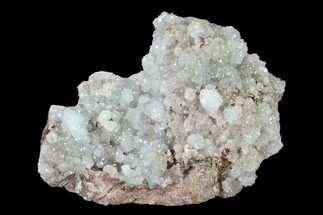This Specimen has been sold.
1" Sparkling Dioptase Epimorph with Mimetite- N'tola Mine, Congo
This is a beautiful epimorph (dioptase cast) formed from sparkling dioptase crystals, collected from the N'tola Mine of the Republic of the Congo. These epimorphs occur as dioptase forms over an unidentified, botryoidal mineral, likely being plancheite or shattuckite. This mine has been closed since 2019, so this material is old stock. The entire specimen is 1" wide, and the dioptase is a lustrous, emerald-green color and formed in association with mimetite.
It has been mounted to an acrylic display base with mineral tack.
It has been mounted to an acrylic display base with mineral tack.
Dioptase is an uncommon mineral, found mostly in desert regions where it forms as a secondary mineral in the oxidized zone of copper sulfide mineral deposits. This copper-based mineral forms small rhombohedral crystals, typically less than 0.75 centimeters in length. It is popular with mineral collectors due to its vibrant color and it is occasionally cut into small emerald-like gems.
About Mimetite
Mimetite is a rare lead arsenate chloride mineral, often found in shades ranging from bright yellow to orange, brown, and occasionally green. Its crystals form in a hexagonal structure, typically appearing as prismatic or rounded barrel shapes, though they can also form in botryoidal or globular clusters. This mineral belongs to the apatite group and is closely related to pyromorphite and vanadinite, with which it can sometimes be found in mixed forms. Mimetite's vibrant colors and crystal formations make it a popular specimen among mineral collectors, as it is often highly aesthetic and eye-catching.
This mineral is usually found in the oxidized zones of lead ore deposits, commonly associated with minerals such as galena, wulfenite, and cerussite. It can be found in notable deposits worldwide, including locations in Mexico, Namibia, and Australia, where large and well-formed specimens have been unearthed. Mimetite crystals are relatively fragile due to their lead and arsenic content, requiring careful handling. Despite its appeal, mimetite is not used in jewelry or as a decorative stone because of its toxic elements, making it mainly a collector's mineral.
Mimetite is a rare lead arsenate chloride mineral, often found in shades ranging from bright yellow to orange, brown, and occasionally green. Its crystals form in a hexagonal structure, typically appearing as prismatic or rounded barrel shapes, though they can also form in botryoidal or globular clusters. This mineral belongs to the apatite group and is closely related to pyromorphite and vanadinite, with which it can sometimes be found in mixed forms. Mimetite's vibrant colors and crystal formations make it a popular specimen among mineral collectors, as it is often highly aesthetic and eye-catching.
This mineral is usually found in the oxidized zones of lead ore deposits, commonly associated with minerals such as galena, wulfenite, and cerussite. It can be found in notable deposits worldwide, including locations in Mexico, Namibia, and Australia, where large and well-formed specimens have been unearthed. Mimetite crystals are relatively fragile due to their lead and arsenic content, requiring careful handling. Despite its appeal, mimetite is not used in jewelry or as a decorative stone because of its toxic elements, making it mainly a collector's mineral.
SPECIES
Dioptase & Mimetite
LOCATION
N'tola Mine, Mindouli, Mindouli District, Pool Department, Republic of the Congo
SIZE
1 x .8"
CATEGORY
ITEM
#209668
 Reviews
Reviews












